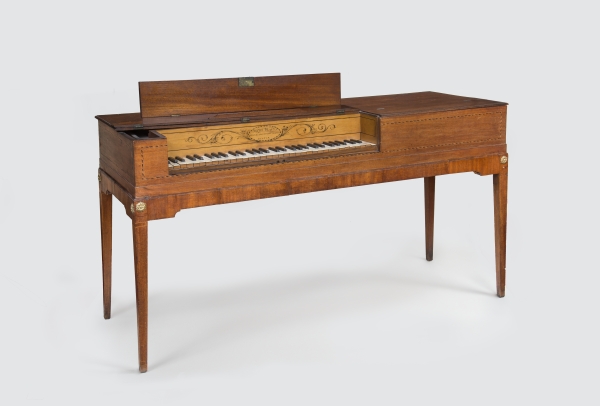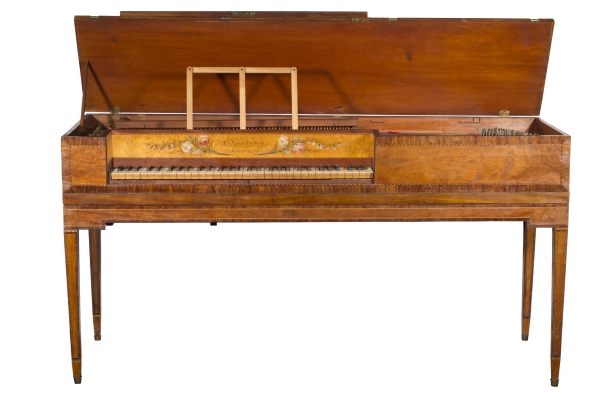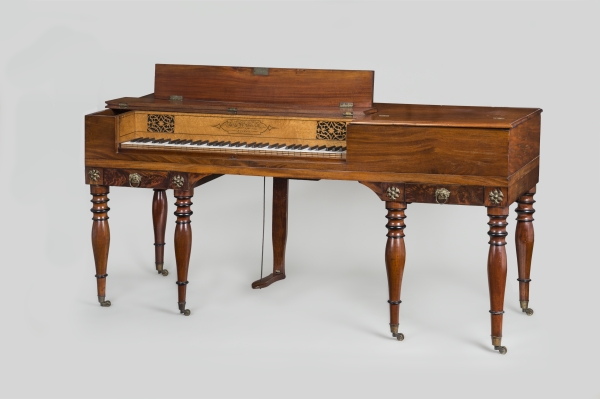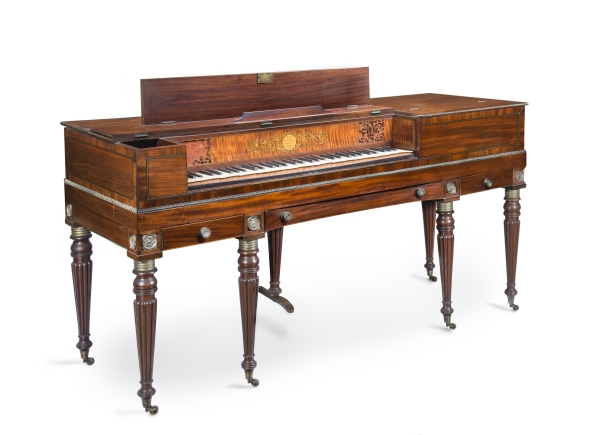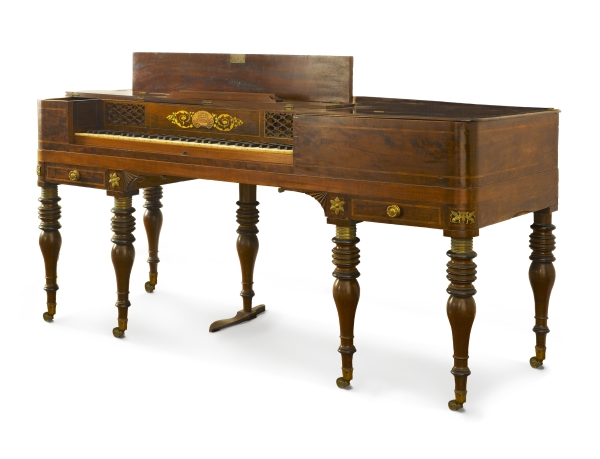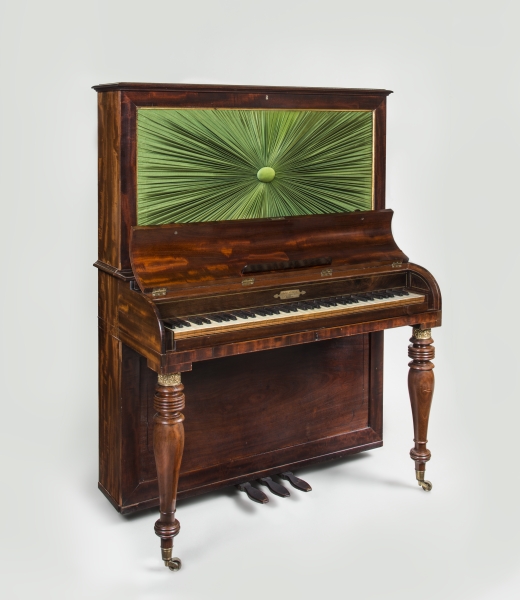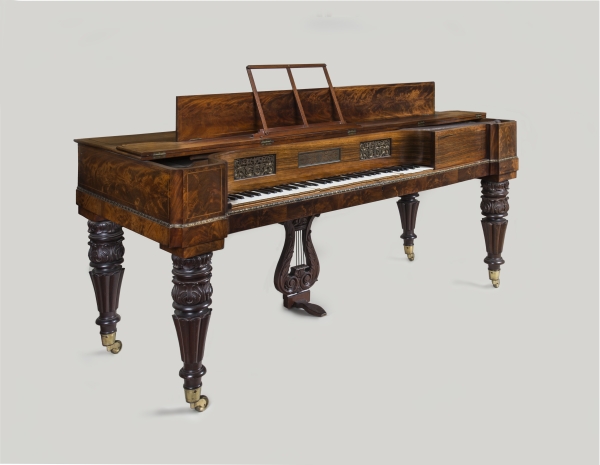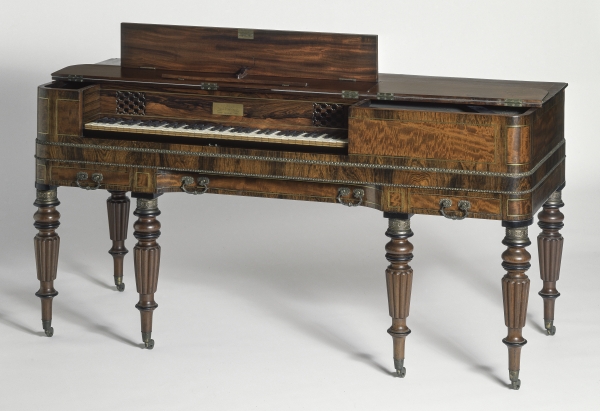· 17 ·
Early Pianomaking in Boston, 1790–1830
DARCY KURONEN
Modern research has shown with considerable certainty that the piano was invented by Bartolomeo Cristofori about 1700 in Florence, Italy. But it was not until the 1760s that the instrument became popular enough to be produced on a commercial scale, with England leading the way.1 And not until about 1800 did the piano finally eclipse its stringed-keyboard predecessors, the harpsichord and clavichord. During the eighteenth century, wealthy New England colonists imported harpsichords, as well as smaller versions, known as spinets and virginals. The majority of these instruments were English made, like so many other goods procured from abroad.2
Pianos were likewise imported to America starting in the 1770s, and England was again the most common source. A few pianos were made in the American colonies prior to the War of Independence, but not until the conclusion of the hostilities did instrument makers begin in earnest to turn their attention toward pianomaking. Boston-area craftsmen lagged only slightly behind those in Philadelphia and New York City in creating their first pianos, and the industry in Massachusetts would grow to one of great importance by the mid-nineteenth century. In examining early Boston pianomakers, it becomes apparent that well-defined relationships existed between the first few generations of these craftsmen, who taught and/or worked for one another in various partnerships.
The piano, more properly called the pianoforte in English-speaking countries, is capable of producing tones that are both soft (piano) and loud (forte). The mechanism causes small leather-covered mallets to be propelled at the strings with varying power, depending on how forcefully the player depresses the keys. This flexibility of tone production was well suited to the musical style that developed in the second half of the 1700s, in which expression of dynamics was increasingly important. The harpsichord, by contrast, is incapable of dynamic shading because its mechanism causes the strings to be plucked by small plectra made of bird quill, always with the same volume.
Pianos during this early period were produced in three principal forms. The most elaborate and expensive was the grand piano, whose case is shaped somewhat like a harp laid flat, that is, essentially a triangular form. Only scant written evidence exists of grand pianos being built in the United States prior to 1840, and almost no extant instruments survive from before that time. Various types of upright pianos were gradually introduced in the late 1700s, but this style did not become prevalent until the 1830s. The most common model during this time was the square piano, so called because of its rectangular shape and square corners. Relatively compact and well suited to domestic interiors, this piano style overwhelmingly dominated American piano production until the mid-nineteenth century.
Although their primary function is to create musical sound, pianos have always exhibited the same level of woodworking and often the same elements of visual design as other contemporary furniture. This study provides an overview of Boston-area pianomakers active prior to 1830 and examines the furniture styling that they used in their instruments.3
The first Massachusetts pianomaker, Benjamin Crehore (1765–1831), built instruments in the town of Milton, just south of Boston.4 His ancestors had settled in Milton by the mid-1600s, and over the generations his family counted many woodworkers. Crehore reportedly possessed an inventive mind and was described in sources from the late 1800s as an “ingenious mechanic” who could create anything. He had begun building musical instruments by the late 1780s and is said to have produced violins, guitars, and drums, in addition to the extant cellos and pianos from his workshop. He is the first New England instrument maker survived by a notable body of work.
Crehore’s earliest pianos are documented from the mid-1790s; of the nine surviving examples, all are square models, clearly derived from English instruments. Evidence has recently surfaced, however, indicating that Crehore produced a grand piano in 1799.5 All these pianos were apparently produced at his home workshop in Milton, and although a few were reportedly sold through a distributor in New York, most were surely sold in Boston. Between May 1798 and July 1799, Crehore was in a short-lived partnership with a musician named Peter Von Hagen Sr. (1755–1803) for the purpose of manufacturing and selling pianos. Another of his brief partnerships involved a local organ builder named William Goodrich (1777–1833). An agreement the men signed in July 1804 stated their intention to build so-called organized pianos, which combined the elements of a piano and an organ into a single case, with both instruments controlled from a single keyboard. The agreement was terminated five months later, and there is no evidence of any surviving instruments, though Goodrich later constructed a few organized pianos and continued to have business relationships with other local keyboard instrument manufacturers.
None of Crehore’s pianos are dated, though a rough chronology can be assigned. His earliest instruments have certain peculiarities, indicating that at first he failed to completely understand the construction of the English pianos he was imitating. His work improved over time, both structurally and visually. The casework of Crehore pianos is always mahogany, solid in his earliest instruments and veneered in one of the latest examples (fig. 1). Like many square pianos of this period, the backs are not veneered because the instruments were always placed against a wall. Light-colored veneer surrounds the area around the keyboard (the key well), with holly used in his earliest pianos and bird’s-eye maple in one late instrument. Relatively plain stringing usually outlines the casework, which is made up of alternating dark and light lines of wood, although two instruments are inlaid with a geometric pattern. The cases invariably rest on what is called a French frame stand, held together with bed bolts that are covered by decorative brass medallions. This type of stand became popular for English square pianos around 1780, replacing an earlier trestle-type stand.6 The legs on these stands are square and tapered, with narrow reeding on two of Crehore’s instruments. Full-length shelves are often found on the stands of English pianos, but it appears that those on some of Crehore’s instruments were added later.
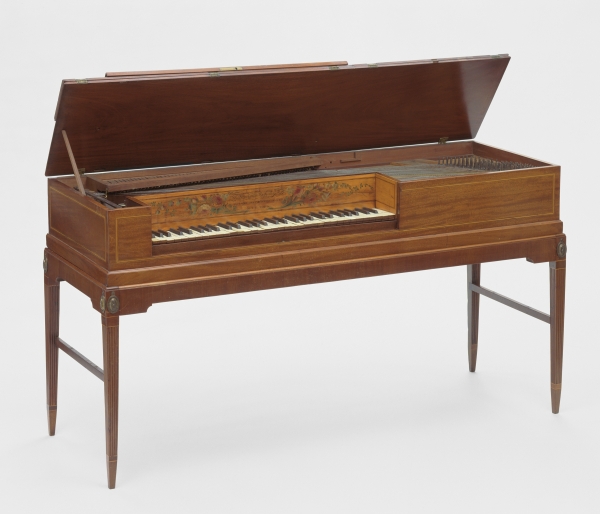
FIG. 1. Square piano, Benjamin Crehore (1765–1841), Milton, Mass., ca. 1800. Mahogany, holly; h case 95/16, h with stand 33⅝, w 6111/16, d 225/16. Museum of Fine Arts, Boston; Gift of Camilla Cunningham Blackman in memory of Lucy Clarendon Crehore (1992.95).
The nameboard decoration on Crehore pianos (see figs. 5, 6) is of particular interest because it was, in some instances, almost certainly executed by the Boston ornamental painter John Ritto Penniman (1782–1841).7 This decoration consists of painted flowers and leaves, and though imitative of ornamentation on some English pianos of the period, the work is distinctly in Penniman’s style. No evidence exists that Penniman worked directly with Crehore, but they surely traveled in the same circle of artisans. Their relationship is reinforced by a watercolor portrait that Penniman painted of Crehore’s granddaughter in 1832 and by a Penniman watercolor-and-ink drawing of an unusual piano (fig. 2) that was found in the attic of a house that had belonged to Benjamin’s brother William Crehore.8
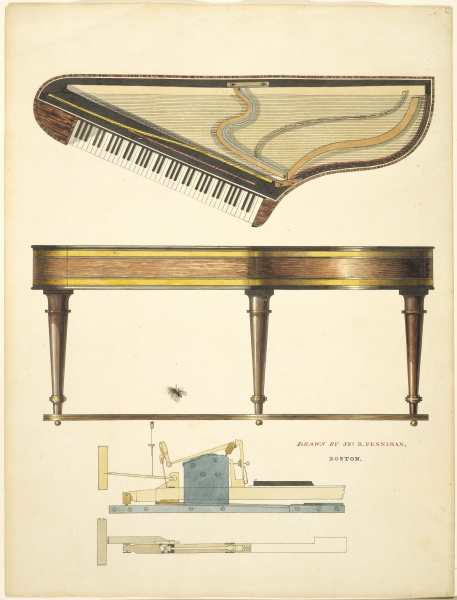
FIG. 2. Piano in the Shape of a Bentside Spinet, John Ritto Penniman (1782–1841), Boston, ca. 1830. Watercolor, ink, and graphite on paper; h 16, w 12⅜ (sight). Museum of Fine Arts, Boston; Gift of Mr. and Mrs. William Rust (1980.656).
Had Crehore built only a few pianos, he would still be important for having taught his craft to two pairs of brothers from Milton. The first was William Bent (1772–1851) and his younger brother Adam (1776–1857), who, after completing their training, established a shop at 90 Newbury Street by 1798, making them the first pianomakers in Boston proper. In that same year, city directories show them working with William Green (act. 1798–1817), a maker of bowed string instruments, but by 1800 they had ceased this partnership and moved their shop to 26 Orange Street. From about 1807 to 1809, William continued making pianos on his own, while Adam was involved with real estate in South Boston.
Structurally, the pianos produced by the Bents largely mimic those of Crehore, and only four extant instruments (all square models) provide a basis for evaluating their work (fig. 3). A notable change in furniture design that occurs on one of their pianos is the replacement of a French stand with six separate legs, a feature first seen on English square pianos about 1806.9 The nameboards (fig. 4) on the Bents’ surviving pianos are not decorated as nicely as those by Crehore, though it is possible that one or more of them was painted by Penniman.
FIG. 3. Square piano, William (1772–1851) and Adam (1796–1857) Bent, Boston, 1800–1805. Mahogany, holly; h case 813/16, h with stand 33 7/8, w 62¼, d 21. Historical Society of Old Newbury (Museum of Old Newbury), Newburyport, Massachusetts. Photo, Gavin Ashworth.
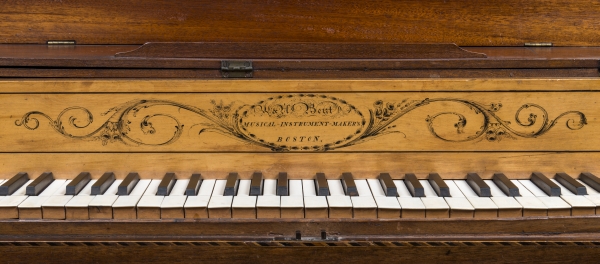
FIG. 4. Nameboard on the piano in fig. 3. Photo, Gavin Ashworth.
Crehore’s tutelage did not take lasting root with the Bents, but he fared better with two other brothers from Milton: Lewis Babcock (1779–1814) and his younger brother Alpheus (1785–1842).10 Although their apprenticeship to Crehore has long been known, a piano recently surfaced that furthers our understanding of this relationship (fig. 5). The nameboard is marked “Crehore and Babcock,” suggesting that at some point master and apprentice formed a partnership. The instrument presumably dates before 1810, when the Babcock brothers opened a shop in Boston; the Babcock listed on the nameboard is almost certainly Lewis, as his initial is listed first on later instruments signed by the two brothers, and Alpheus would have been rather young to serve as a business partner prior to 1810. This instrument is considerably fancier than other Boston pianos of the time, displaying more elaborate veneer and stringing. The case panels are of figured mahogany outlined with geometric stringing and crossbanding of what appears to be rosewood. One researcher has suggested that the shop of Thomas Seymour was almost certainly involved in producing the casework of this handsome piano.11 The beautifully preserved nameboard, veneered with what appears to be figured satinwood and painted decoration almost certainly executed by Penniman, underscores the exceptional nature of this instrument (fig. 6).
FIG. 5. Square piano, Crehore and Babcock, Milton, Mass., 1805–10. Mahogany, holly; h case 89/16, h with stand 32⅝, w 62¾, d 22⅜. Marlowe A. Sigal Collection, Newton Centre, Massachusetts (2011.08).
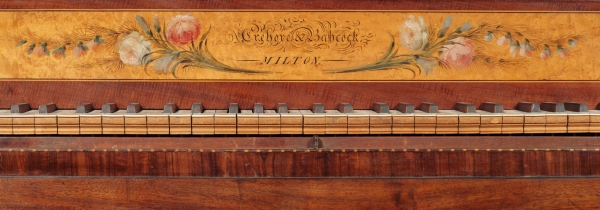
FIG. 6. Nameboard on the piano in fig. 5.
The Babcock brothers set up their own shop in Boston in 1810, at 49½ Newbury Street. Two extant instruments signed by the pair differ from the work of Crehore in the case styling, keeping pace with changing tastes in pianos and other furniture. Six separate legs are now the norm, with simple baluster turning on one example but reeding on the other. A new feature found on one of these two instruments is a pair of drawers, suspended below the case and placed between the front legs. On the nameboard of this same piano is another element introduced in England in 1794: a pair of delicate fretwork openings that allow sound to better escape from the interior when the lid is closed (figs. 7, 8). The other surviving piano lacks fretwork openings in its nameboard, but a fretwork panel of mahogany (backed with green cloth) is placed in a triangular space inside at the right rear corner of the case, behind the soundboard and strings.12 This same piano’s key well terminates in gentle curves rather than 90-degree angles. It is an elegant way to construct the ends of this opening in the casework but curiously was used only occasionally on subsequent Boston pianos.
FIG. 7. Square piano, Lewis (1779-1814) and Alpheus (1785–1842) Babcock, Boston, 1810–11. Mahogany, maple; h case 8¼, h with legs 313/16, w 64½, d 237/16. Willard House and Clock Museum, Grafton, Massachusetts. Photo, Gavin Ashworth.
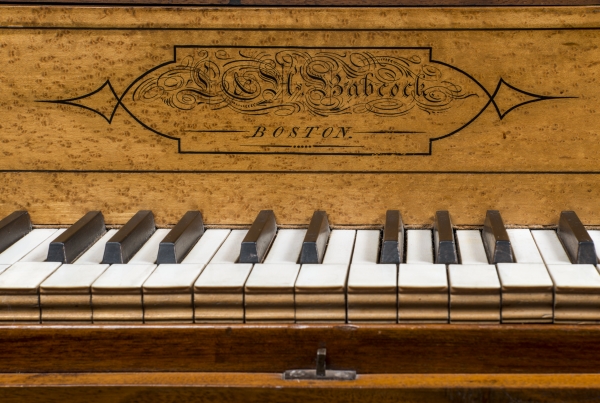
FIG. 8. Nameboard on the piano in fig. 7. Photo, Gavin Ashworth.
In this period, piano lids were kept closed much of the time. This is proved by the presence of much less finish on the underside than on the exterior, as well as a frequent provision for positioning music against a ledge attached to the lid, even if a folding music desk is attached behind the nameboard for use when the lid is propped open. Moreover, the mechanical elements of square pianos, which are visible when the lid is open, were often disguised by a long, thin cover of wood that lay above the strings. Scholars have debated whether these so-called dust covers served an acoustic function or were intended to prevent debris from getting inside the instrument. The consensus is that their primary purpose was to create a more elegant appearance when a piano lid was open. These panels are typically painted on the upper surface, usually a rich dark green and often with pinstriping around the edges and occasionally other decorations at the corners. Some examples are covered with colored silk.13
During their careers, the Babcock brothers formed manufacturing arrangements with other craftsmen and received financial backing from businessmen. After the apparent collaboration with Crehore, the next partnership was put in place for two years, between 1812 and 1813, when the brothers worked at 18 Winter Street with Boston organ builder Thomas Appleton (1785–1872), signing their work “Babcock, Appleton, and Babcock.” Much of what we know about this period of Boston piano manufacture comes from reminiscences of Appleton, written in a letter from 1872.14 He recalled that one of the craftsmen they employed was none other than Benjamin Crehore, whom Appleton remembered as “a rather old man,” even though he was only forty-five years old at the time.
Another significant statement by Appleton is that he and the Babcocks persuaded James Cogswell (1780–1862) to take charge of making the cases for their pianos; Appleton counted him as the best cabinetmaker in Boston at the time. Little is known of Cogswell, though he was a distant cousin of John Cogswell (1738–1819), another important Boston cabinetmaker. James was briefly in partnership with Thomas Seymour in 1804 and is also believed to have made some of the cases for Appleton’s pipe organs after about 1830, when Appleton was solely in the business of making such instruments.15 When Cogswell came to the Babcock and Appleton shop, he brought an apprentice named John Osborne (1791/92–1835), to whom Crehore was assigned to teach “the interior work of pianos.”16 In June 1812, William Goodrich likewise joined the shop to help Appleton build pipe organs offered by the partnership.
Four pianos survive from the partnership of Appleton and the Babcocks, exhibiting increased quality over Boston-made instruments from the two previous decades. Six-legged models are now standard, along with the frequent presence of two drawers (fig. 9). The drawer pulls and other decorative hardware were surely purchased from the same sources that were supplying local furnituremakers. Brass stringing begins to be incorporated, outlining the mahogany-veneered panels on the front and sides, along with a small brass molding near the bottom edge of the case. The legs are turned and reeded, with brass collars of varying patterns. Also more common is decorative fretwork in the nameboard, along with a fretwork panel inside the case, behind the soundboard.
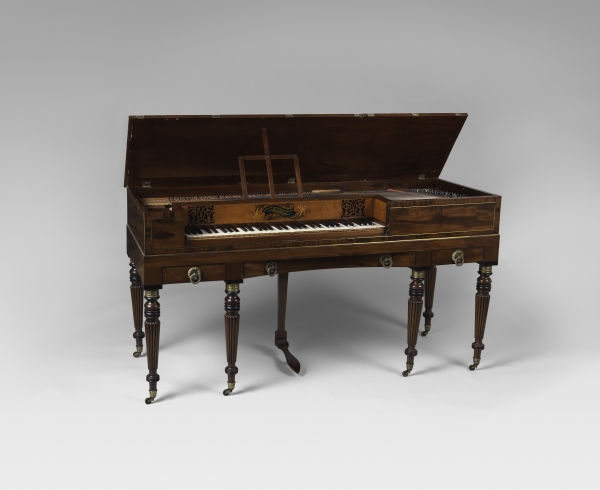
FIG. 9. Square piano, Babcock, Appleton, and Babcock, Boston, 1812–13. Mahogany, maple; h case 95/16, h with legs 377/16, w 661/16, d 23½. Metropolitan Museum of Art; Bequest of Helen Wood Pope, 2001 (2001.364 a, b).
Lewis Babcock died in January 1814, and Alpheus formed another partnership that lasted the next two years, keeping Appleton but adding Charles and Elna Hayt, dry-goods merchants in Boston. The new business was located at 6 Milk Street, near the Old South Meeting House. Of four surviving instruments by this partnership, some are labeled “Hayts” and some “Hayt,” which probably reflects Elna leaving the partnership in June 1815. A newspaper advertisement at this same time indicates that Appleton and Charles Hayt carried on the business, but no mention is made of Alpheus Babcock, who seemingly disappears from the Boston pianomaking scene for the next five or so years. Goodrich was once again brought in to help, but he was not a partner. At some point, Charles Hayt reportedly moved to Buffalo, New York, signaling the end of the firm.17
Stylistically, the pianos by this partnership do not differ markedly from those made by the previous collaboration of Babcock and Appleton. The cases are still mahogany veneered with brass stringing, with fretwork openings in the nameboard, and six turned and reeded legs with brass collars (figs. 10, 11). Drawers below the case are still present, but a wider central drawer has been introduced. This additional drawer gives the case a more balanced appearance, and its front is made concave to allow more room for the player’s knees. A subtle difference on one of these four pianos appears in the front corners, which are slightly rounded rather than square, a feature that becomes prevalent on many Boston pianos of the 1820s.
FIG. 10. Square piano, Hayt, Babcock, and Appleton, Boston, 1814–15. Mahogany, maple; h case 161/16, h with legs 34½, w 6513/16, d 237/16. Historic New England; Gift of Constance McCann Betts, Helena Woolworth Guest and Frasier W. McCann (1942.3820). Photo, Gavin Ashworth.
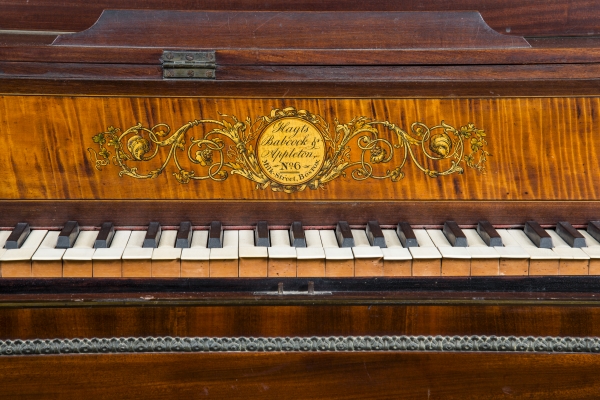
FIG. 11. Nameboard on the piano in fig. 10. Photo, Gavin Ashworth.
With the departure of the Hayts from the partnership, some of the remaining makers were reorganized at the same address on Milk Street. This time, capital was supplied by a successful mariner and merchant named John Mackay (1774–1841), who played a prominent role in Boston’s piano industry for many years.18 The new company was called the Franklin Music Warehouse, because it was located at the site of Benjamin Franklin’s birthplace. Over the next few years, the name Franklin Music Manufactory was sometimes used to refer to this business. The proprietor or agent for the company was John Rowe Parker (1777–1844), a merchant, publisher, and editor. He had previously published a musical journal in Boston and worked in New London, Connecticut, importing pianos from New York.19
Although Parker was apparently the manager of the Franklin Music Warehouse, the foreman of its manufacturing was reportedly Joshua B. Stephens (ca. 1788–1819), about whom almost nothing is known.20 He is listed in the 1813 city directory as a cabinetmaker on Charles Street, though the next year’s tax records show him as an “instructor” at Milk Street. In 1818, the directory lists him as a “musical instrument maker,” whereas tax records specify him as a “pianoforte maker.” His sudden managerial role in the new venture on Milk Street is a bit puzzling, given that he oversaw the work of experienced craftsmen. Stephens died in 1820, and James Cogswell helped inventory his estate.
Babcock’s name is noticeably absent in mentions of this new firm, and he seems to disappear from Boston’s public records. Goodrich is quoted as saying that “in consequence of various embarrassments and misfortunes, this concern [the Franklin Music Warehouse] underwent a great variety of transformations.”21 A later source stated that Babcock left Boston in 1817 and moved to Philadelphia, but he returned after the death of Stephens.22 Perhaps Babcock temporarily left Boston because of a disagreement regarding the position that Stephens held at the new firm. In any event, Babcock developed a relationship with a Philadelphia instrument distributor in the 1820s, so perhaps the groundwork for his collaboration with that dealer was laid during an absence from Boston.
Only three extant pianos bearing the Franklin Manufactory name on nameboards have been documented; each also includes the name “J. B. Stevens” and no other. The location of two of these instruments is unknown and the third is in a private collection, so details about their appearance are limited. Based on photographic evidence, the pianos appear to be quite handsome, with somewhat fancier veneer work than on other Boston pianos of the period (fig. 12). Like one of the instruments by the Babcock brothers described above, two of the Stephens pianos have key wells that end with elegant curves rather than right angles. The front case corners are likewise gently curved, as was increasingly common. Scrolled patterns that had been used for fretwork openings in the nameboard give way to a trellis pattern, another feature regularly found in Boston pianos of the 1820s.
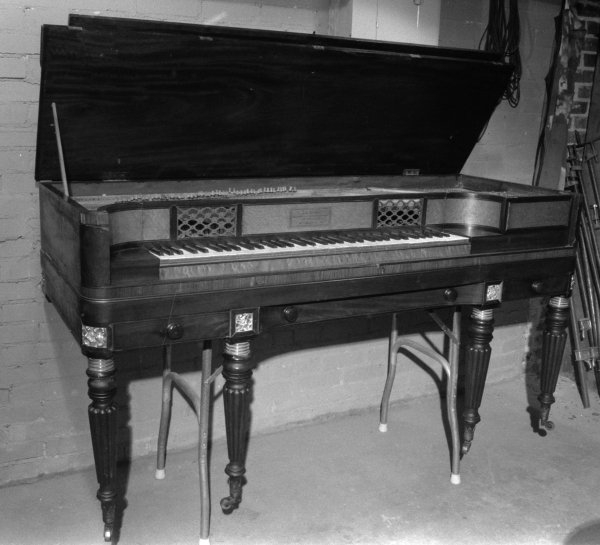
FIG. 12. Square piano, Joshua B. Stevens, Franklin Manufactory, Boston, 1816–20. Mahogany, maple; h case 10⅜, w 66⅜, d 26⅜. Private collection. Photo, John Watson. This example is shown here prior to conservation.
With the Franklin Musical Warehouse, one finds the first mention of upright pianos in Boston. In February 1819, Parker published a boastful piece stating that a cabinet pianoforte (meaning an upright model) had been produced in New York and was said to be the first ever made in the United States. Parker rebutted this claim, stating that since 1813 more than fifty such instruments had been produced by his firm. This exchange is tantalizing precisely because not a single example is known to survive. Parker went on to say that his manufactory finished two instruments per week, a number that fell short of customer demand.23 The shop at 6 Milk Street was clearly producing a steady stream of instruments, even if only a few remain to allow us to interpret this transitional moment in Boston’s piano history.
By 1816, John Osborne left the firm on Milk Street and set up his own shop at the back of 3 Newbury Street. Based on recollections of those who had known him, Osborne was characterized as being “of a sensitively exacting nature, which is somewhat indicative of the ability he evinced throughout his life as a pianoforte improver, for he was one of the most nervously progressive men of his time.” He was further described as “a man of superior intellect and belligerent to a high degree.”24 It is no surprise, then, that he was anxious to start his own shop rather than work under the direction of others. It seems likely that he was born in Boston, though this detail has yet to be documented.
Osborne moved his Boston shop twice; this information is invaluable in dating his surviving pianos, which often bear a business address. By 1818, he was at 12 Orange Street, and then in 1822 he moved to Boylston Market, where he seems to have remained until the end of the decade. Creating a basic chronology is further assisted by three-digit numbers stamped on many of his pianos; however, these may not be reliable as cumulative serial numbers because anomalies often appear when they are juxtaposed with other characteristics of his instruments.
For a short time, beginning sometime before November 1822, Osborne took on a business partner named James Stewart (1775–1860), a Scotsman who had been making pianos in Baltimore and Philadelphia.25 According to Appleton, both men were “quick-tempered,” which soon caused them to quarrel and separate. In February 1823, Stewart formed a new partnership with one of Osborne’s apprentices, Jonas Chickering, who would go on to become Boston’s most successful pianomaker. Osborne continued business in Boston until 1829, after which he turns up in Albany and New York City, apparently operating shops in both areas for a time.
Osborne’s early square pianos bear a basic resemblance to other Boston instruments made between 1815 and 1820. Over the course of his career, however, he incorporated considerable variety in the decorative features of his instruments, and one seldom finds two of his pianos that bear much resemblance to each other. This suggests that his instruments were likely made to accommodate different price ranges or were decorated to suit the desires of individual customers. In Osborne’s earliest pianos, the cases typically have rounded front corners and predictably are veneered with mahogany (figs. 13, 14). The key well is often veneered with a lighter wood, such as maple, which gradually gives way to rosewood. The cases and lids are adorned in varying degrees with crossbanding (mahogany or rosewood), stringing (brass or contrasting woods), and brass moldings. In at least one instance, stamped-brass ornaments have been applied to the corners of the case and above the legs. Openings in the nameboard, when present, form a trellis pattern and are backed by cloth (usually silk). The piano may have four legs, with no drawers, or six legs, with either two or three drawers below the case. Until the mid-1820s, the legs are most often a simple baluster turning with no reeding, but a decorative brass collar is sometimes present at the top. The single pedal on a few of these pianos is attached to a simple wood slat, but Osborne soon adopted a lyre-shaped frame to support the pedals, a form closely linked with neoclassical design.
FIG. 13. Square piano, John Osborne (1791/92–1835), Boston, 1818–21. Mahogany, rosewood; h case 815/16, h with legs 327/16, w 66⅜, d 25⅜. Nantucket Historical Association, Nantucket, Massachusetts (1983.0139.001). Photo, Jeffrey Allen.
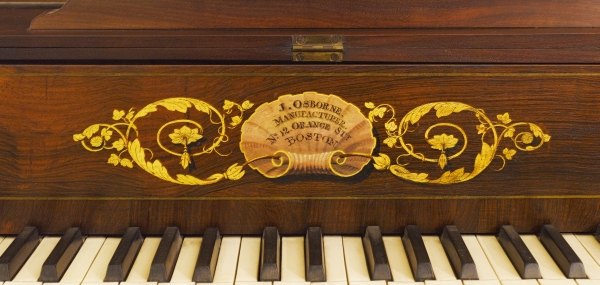
FIG. 14. Nameboard of the piano in fig. 13. Photo, Jeffrey Allen.
Only twenty-five pianos have been discovered that date from Osborne’s Boston career. Two are highly significant, being among the earliest known upright pianos made in America (fig. 15).26 They date from between 1818 and 1821 and bear sequential stamped numbers (152 and 153). Parker stated that the Franklin Musical Warehouse started making upright pianos in 1813 and had produced fifty such instruments by 1819, so Osborne would have been familiar with their construction. Superficially, Osborne’s two upright pianos are similar in construction and decoration, though they vary in height by 21¼ inches, the larger of the two standing almost 75¼ inches tall. This detail again shows a lack of slavish consistency in Osborne’s work and may reflect his “nervously progressive” nature. The decorative elements on these upright instruments are not dissimilar from those on Osborne’s square models, with one obvious difference: the large panel above the keyboard. Whereas modern upright pianos are constructed with wood upper panels that are typically solid, tall early uprights like Osborne’s display a frame with radially pleated cloth, allowing the sound to better project out the front of the instrument.27
FIG. 15. Upright piano, John Osborne, Boston, 1818–21. Mahogany, rosewood; h 5711/16, w 439/16, d 211/16. Old Sturbridge Village, Sturbridge, Massachusetts (10.17.73). Photo, Gavin Ashworth.
Around 1824, Osborne introduced a more massive style of square piano (fig. 16). This appearance is partly related to the incorporation of a larger number of keys and strings (called for by music of the time), which necessitated a larger case. Some of the change also reflects the adoption in pianos of more robust and up-to-date styling. The most noticeable construction feature is the front corners of the case, which now form a sort of projection or pilaster above the legs. Mahogany veneer continues to be used for the bulk of the casework, with rosewood as a contrasting accent, both in the key well and as stringing and crossbanding.
FIG. 16. Square piano, John Osborne, Boston, 1824–29. Mahogany, rosewood; h case 9¾, h with legs 27⅝, w 67, d 251/16. Old Sturbridge Village, Sturbridge, Massachusetts (10.17.99). Photo, Gavin Ashworth.
Brass takes a stronger ornamental role in these later Osborne pianos, its appearance starting front and center with the maker’s name and address engraved into a brass plate on the nameboard (fig. 17). The nameplate is often flanked by grillwork vents that are likewise made of brass, now in a foliate pattern. (An identical pattern had been executed in wood on some of Osborne’s earlier pianos.) Gilt-brass moldings are still present on the cases, and one exceptional instrument also displays an elegant use of brass in the form of a lyre inlaid into part of the front lid flap that is formed like the case’s projecting corners.28 This new style has only four legs, which are larger and vary considerably in form. Some legs incorporate carving, along with large reeding on the long sections. The carving sometimes takes the form of a capital, which integrates the legs architecturally with the pilaster-like projections above. Drawers are no longer incorporated, but Osborne retained the lyre-shaped support for the pedal, increased in size to match the rest of the instrument and often carved on its front.
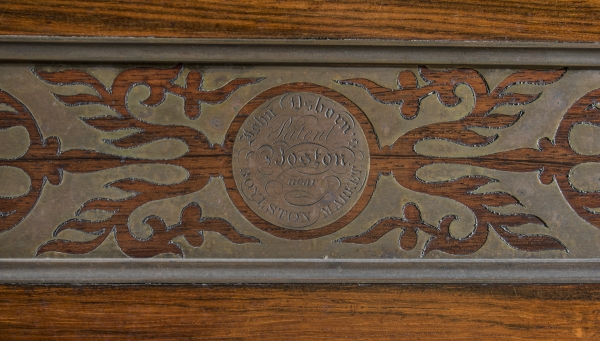
FIG. 17. Nameplate and grillwork of the piano in fig. 16. Photo, Gavin Ashworth.
Alpheus Babcock was conspicuously absent from the group of craftsmen working at the Franklin Musical Manufactory and supported by John Mackay, but he resurfaces in Boston in the early 1820s and, through the end of the decade, flourishes as a pianomaker with support from two other Mackay family members. The first was George D. Mackay (d. 1824), possibly a nephew of John Mackay and likewise involved in maritime shipping.29 By 1822, he set up a shop with Babcock at Parkman’s Market, near the Old West Church. Their instruments are marked “Made by A. Babcock for G. D. Mackay,” typically engraved on a brass nameplate. This wording has confused many researchers who encounter instruments marked in this way, for they assume that such a piano was made specifically for a client named Mackay. This assumption is understandable since labeling a piano with both the name of the maker and a financial supporter is uncommon. Whether Babcock was a business partner of George D. Mackay or just the foreman of his piano shop is unknown. Whatever the arrangement, it ended abruptly in December 1824, when Mackay was lost at sea. His probate provides a wealth of information; the entire shop was inventoried, including all the different materials present for making pianos and the value of both finished and unfinished pianos present in the shop. Most significant is the mention of an unfinished grand piano, which is only the second time that such an instrument can be documented as having been made in Boston prior to 1840.
With the death of George Mackay, another family member stepped in to support the business, and little if any gap appears to have occurred in the production of pianos by the shop. Ruth Mackay was the mother of John Mackay, and instruments made during her involvement with the firm are labeled “Made by A. Babcock for R. Mackay,” again engraved on a brass nameplate. Whether Ruth was the sole backer of the business is uncertain; it is entirely possible that John was financially involved, albeit silently, just as he had been with the Franklin Musical Warehouse. Such an arrangement is equally likely to have been in place with George Mackay. Toward the end of the 1820s pianos appear that are marked simply “Made by A. Babcock,” a label that raises questions. Perhaps at this point, Babcock was the sole owner of his shop, but it is equally possible that he continued to receive support from the Mackay family, though as silent partners, without the Mackay name included on the instruments’ nameplates.30
Further confusing the issue of labeling on Babcock’s instruments is the presence of nameplates indicating business arrangements with three other distributors. The most straightforward are instruments marked “Made by A. Babcock for J. A. Dickson.” James A. Dickson (1774–1853) was the owner of a “Music Saloon” at 1 Marlboro Place in Boston; he obviously had some kind of relationship with the Babcock shop to make instruments that he would then sell through his music store.
Several pianos are marked “Made by A. Babcock for J. G. Klemm, Philadelphia.” John George Klemm (b. 1795) was a distributor of musical merchandise in Philadelphia, and many researchers have surmised that instruments marked in this way were produced by Babcock between 1830 and 1837, a period when he is known to have worked for Klemm in Philadelphia. But evidence suggests that these pianos were produced in Boston during the 1820s and shipped to Klemm’s Philadelphia store. Chief among this evidence is a piano marked “Made by A. Babcock for C. Hall, Norfolk.” Babcock never worked in Norfolk, Virginia, for the piano dealer Charles Hall, so here was obviously another business arrangement whereby Babcock manufactured pianos for sale by a distributor in a different city. Further evidence that the “Klemm” instruments were made in Boston, rather than Philadelphia, stems from their serial numbers, which mesh comfortably with those of other Boston-made pianos from Babcock’s shop, instead of reflecting what would almost surely have been a higher or completely different numerical sequence that Klemm would have used after 1830. Moreover, the case styles of the surviving Klemm instruments are very much like those of the other Babcock instruments from the 1820s and would have been considered quite old-fashioned if they were produced in the 1830s. Lastly, it is known that Babcock established a relationship with Klemm by 1825 (if not much earlier), since in that year the latter exhibited one of Babcock’s pianos at the Franklin Institute Exhibition in Philadelphia.
The serial numbers on Babcock pianos of the 1820s show every indication of being cumulative and thus can serve as a guide by which the dates of manufacture can be assigned within a year or two. The sequence seems to encompass all the instruments of the decade, no matter for whom they were made. Stamped or written in pencil in numerous locations, these numbers range from single digits (starting with 1) to 570 (the highest number yet documented). Whether the latter represents the production of nearly six hundred pianos between about 1822 and 1829 has not been proved, but nearly ninety Babcock instruments from the 1820s have been documented.
If the pianos from Osborne’s shop vary in design and decoration, those created by Babcock during the 1820s are remarkably consistent and similar. In fact, one particular model (if it may be called such) survives in great numbers, suggesting that it was a mainstay of production. Although this model varies slightly in its specific decorative appointments, it can be described as follows. The case, with rounded front corners, is of figured mahogany veneer over a substrate of white pine, with rosewood crossbanding (fig. 18). The lid is similarly veneered and crossbanded. The mahogany case sides are further outlined with brass stringing on each of the separate panels. Rosewood is used to veneer the nameboard, with brass stringing and two trellis-shaped openings flanking the brass nameplate. The openings are typically backed with red, lavender, or green silk. Around the edges of the case and lid are gilt cast-lead moldings of various patterns, though the number of moldings varies depending on how fancy the instrument is (figs. 18, 19). The most deluxe examples have two moldings on the case and one around the edge of the lid. Six reeded legs are standard, with brass collars of slightly varying designs. The two pedals are supported by posts that mimic the design of the legs. Placed between the legs are three drawers with cast-brass handles. Many of the handles are identical, indicating that they were purchased in multiples from a supplier of furniture hardware.
FIG. 18. Square piano, Alpheus Babcock (1785–1842), Boston, ca. 1824. Mahogany, rosewood veneer; h case 8½, h with legs 33⅝, w 66⅛, d 25⅞. Winterthur Museum; Gift of Thelma Josephson in memory of Fred and Edna Redenbaugh (1989.0064).
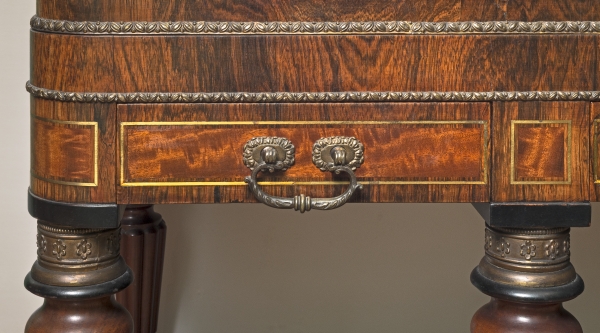
FIG. 19. Gilt moldings, brass collars, and handle of the piano in fig. 18.
Of the nearly ninety known examples of Babcock pianos dating to the 1820s, at least eighty follow this basic design. Not only are they similar in decorative aspects, but their dimensions vary by only fractions of an inch, both inside and out, suggesting that this was indeed a stock model, perhaps made in batches or at least from a standardized pattern. There are simpler four-legged Babcock pianos from this decade,31 and at least one anomalous example with light wood crossbanding and painted decorative swags on the front of the case, providing a dramatic contrast to the mahogany.32 Another style that was produced a few times toward the end of the 1820s has square front corners and between four and six columnar legs with gilt-bronze collars and cuffs.33
Alpheus Babcock was the first to devise a one-piece cast-iron frame to help pianos withstand the tension from increasingly heavier stringing. His patent was issued in Boston in 1825, though the design was slow to catch on and is found in only four of his surviving pianos. It was left to Jonas Chickering to capitalize on the usefulness of the iron frame in the 1840s, a feature now standard in all pianos. Babcock definitively left Boston for Philadelphia around 1830, though his exact reasons are unknown. Perhaps he felt unappreciated, either artistically or financially. Upon his departure, John Mackay became a business partner with Chickering. Babcock stayed in Philadelphia for seven years, working first for Klemm and then at the piano manufactory of William Swift. It is deeply puzzling that only two pianos bearing Babcock’s name from this period have been documented. Babcock returned to Boston in 1837, when he was installed as foreman of the piano factory of Chickering and Mackay. Perhaps he was lured back because of his obvious talents. In any event, it is probably not coincidental that soon after his arrival, Chickering took out his own patent for a one-piece, cast-iron frame for pianos.34
Jonas Chickering (1798–1853) was Boston’s most celebrated pianomaker, and his story is well documented (if a bit glorified) in a biography written immediately after his death in 1853 by Richard G. Parker, the youngest brother of John Rowe Parker.35 Chickering (fig. 20) grew up in New Ipswich, New Hampshire, where at the age of seventeen he began an apprenticeship in cabinetmaking with local craftsman John Gould. Exactly two years later, in February 1818, he moved to Boston to gain more experience. He first inquired for work with James Sharpe, an artist who was also a prominent musician. Sharpe recommended Chickering to the cabinetmaker James Barker, who worked in his same building on Washington Street. Chickering stayed with Barker exactly one year to the day before going to work for John Osborne. At Osborne’s shop, he is said to have become acquainted with all aspects of piano construction, but his principal duty was manufacturing keys. This detail is corroborated by Chickering’s name inscribed on the key frames of two Osborne pianos dating between 1818 and 1821. Chickering was lured away from Osborne’s shop by his former partner, James Stewart, who formed a new partnership with Chickering in 1823. The two men stayed together until 1827, after which Stewart moved to England and Chickering continued under his own name until John Mackay joined him in business around 1830.
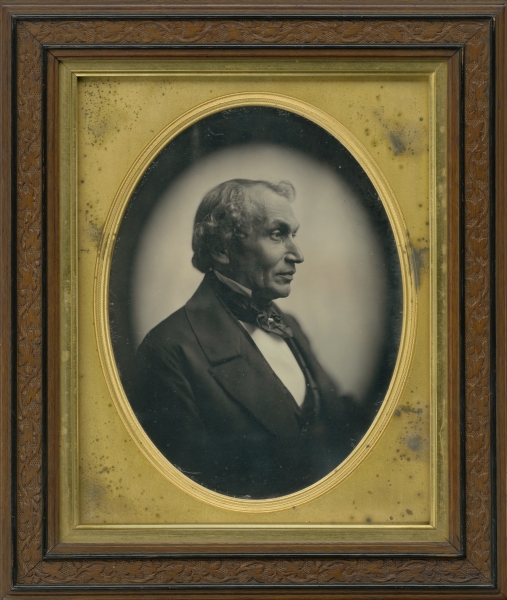
FIG. 20. Jonas Chickering (1798–1853), Southworth and Hawes (act. 1844–62), 1853. Whole plate daguerreotype; h 87/16, w 65/16. National Portrait Gallery, Smithsonian Institution, Washington, D.C. (NPG.95.177).
In evaluating Chickering’s work from the 1820s, one is hampered by a lack of available instruments. Although his shop ledgers survive, indicating that well over two hundred pianos were produced during this period, a scant fourteen have come to light, including two whose locations are currently unknown. Some have suggested that Babcock pianos survive in greater numbers than those made by Osborne and Chickering because of their more attractive appearance.36 Although many early Chickering pianos are not particularly eye catching, exceptions do exist.
As with Osborne’s pianos, it is hard to find any two early Chickering pianos that are overtly similar, at least in decorative elements. Like Osborne’s, Chickering’s shop may have intentionally avoided creating a standard model, as Babcock did, in the interest of offering customers a broader range of case styles and price points. The casework of his instruments is most often veneered in mahogany, with rosewood used as a contrast for the nameboard and as crossbanding or stringing in fancier examples. Toward the end of the 1820s, however, examples appear with casework veneered entirely in rosewood. Brass moldings are applied in fancier instruments, and one example has ormolu-type decorations applied to the nameboard. Some plain Chickering pianos of the 1820s have square front corners, but many others, including the earliest, incorporate projecting front corners like those used by Osborne after about 1824. One fine instrument from 1827 has intricate brass inlay on the nameboard and front corners.37
Chickering typically gave his pianos four legs, the six-legged model having begun going out of fashion in England by the mid-1820s (fig. 21).38 The legs are often reeded, and some include handsomely carved capitals. Like Osborne, Chickering adopted a lyre-shaped frame for supporting the pedals. Drawers are mostly absent, though one instrument dating from about 1828 has three drawers handsomely incorporated into a frame below the piano’s case. One of Chickering most elegant pianos of this period, dating to 1829, makes use of four pairs of columnar legs, with gilt-bronze mounts at their tops and bottoms (fig. 22). This style of leg was used a few times by Babcock on pianos from the late 1820s, and the mounts not only appear to be identical on these Boston-made pianos but also can be found on other furniture of the period, clearly indicating that they were available from a common supplier to the furniture trade.
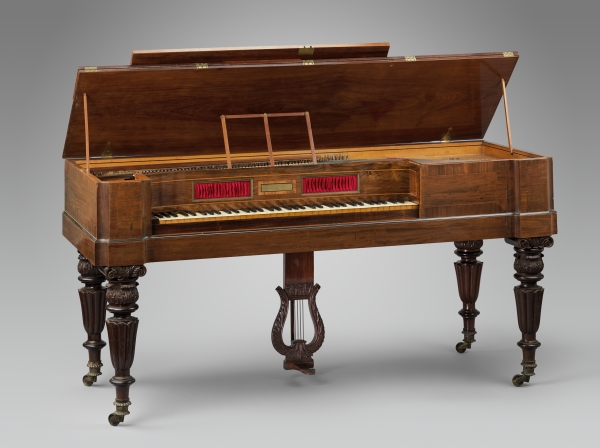
FIG. 21. Square piano, Stewart and Chickering, Boston, ca. 1825. Mahogany, rosewood; h case 1111/16, h with legs 3415/16, w 70¼, d 2713/16. Museum of Fine Arts, Boston; Gift of the Pretzat and Wahl families (2014.1025).
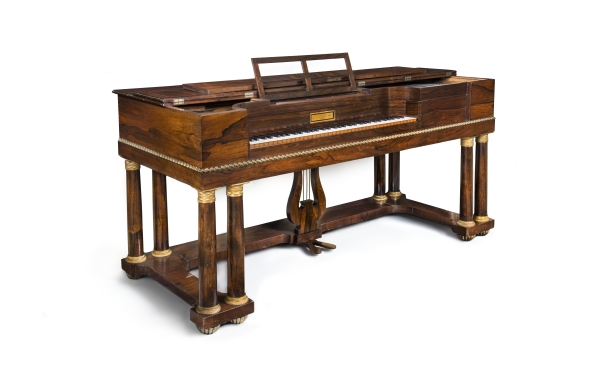
FIG. 22. Square piano, Jonas Chickering, Boston, 1829. Rosewood; h case 11½, h with legs 35½, w 721/16, d 28¼. Salisbury Mansion, Worcester Historical Museum, Worcester, Massachusetts (1987.78SM). Photo, Gavin Ashworth.
Chickering’s company grew rapidly in the decades that followed, and after 1830 the process of making instruments became increasingly industrialized for all piano builders. Boston continued to be a major center for piano manufacture until the early twentieth century, with instruments shipped throughout the world and exhibited at major expositions. This success was built on the foundations laid by a few inventive and skilled artisans working in the late 1700s and early 1800s who created pianos that they believed were musically and visually as good as or better than those procured from abroad. The worldwide success of the American piano industry after 1850 proved them to be correct.

1. See Stewart Pollens, The Early Pianoforte (Cambridge: Cambridge University Press, 1995), 43–95; and Michael Cole, The Pianoforte in the Classical Era (Oxford: Clarendon Press, 1998), 3–14, 43–68.
2. An instructive selection of early English and American pianos is described and illustrated in John R. Watson, Changing Keys: Keyboard Instruments for America, 1700–1830 (Williamsburg, Va.: Colonial Williamsburg Foundation, 2013). For additional images of early American pianos, see Albert R. Rice, Four Centuries of Musical Instruments: The Marlowe A. Sigal Collection (Atglen, Penn.: Schiffer Publishing, 2015); John Koster, Keyboard Musical Instruments in the Museum of Fine Arts, Boston (Boston: Museum of Fine Arts, Boston, 1994); and Laurence Libin, American Musical Instruments in the Metropolitan Museum of Art (New York: W. W. Norton, 1985).
3. An ever-growing database of pianos manufactured prior to 1860 can be found online at http://earlypianos.org.
4. For a thorough examination of Crehore’s career and instruments, see Darcy Kuronen, “The Musical Instruments of Benjamin Crehore,” Journal of the Museum of Fine Arts, Boston 4 (1992): 52–79.
5. This instrument is mentioned in a notice in Boston’s Columbian Centinel of June 19, 1799, where it is clearly differentiated from a square piano. I am grateful to Robert Mussey for sharing this citation with me.
6. Watson, Changing Keys, 58.
7. See Carol Damon Andrews, “John Ritto Penniman (1782–1841): An Ingenious New England Artist,” Antiques 120, no. 1 (July 1981): 147–70.
8. The portrait of Crehore’s granddaughter was sold at Sotheby’s auction house on January 20, 2007 (lot 70).
9. Watson, Changing Keys, 58.
10. The most complete study of Alpheus Babcock’s life and career remains Keith G. Grafing, “Alpheus Babcock: American Pianoforte Maker (1782–1842), His Life, Instruments, and Patents” (Ph.D. diss., University of Missouri–Kansas City, 1972). However, many new facts about Babcock’s instruments and work have come to light.
11. I am grateful to Robert Mussey for initially bringing this piano to my attention and for suggesting its relationship to the Seymour shop.
12. Watson, Changing Keys, 66.
13. See ibid., 72; and Laurence Libin, “An Open and Shut Case,” Early Music 15, no. 1 (Feb. 1987): 76. These wood panels are often missing, but their ubiquitous use is documented by small wood blocks glued at various points to the inner rim of the case to support them.
14. Thomas Appleton, “The Music Trade: The American Pianoforte Manufacture,” Musical and Sewing Machine Gazette (Feb. 21, 1880): 35.
15. Barbara Owen, The Organ in New England (Raleigh, N.C.: Sudbury Press, 1979), 87.
16. Appleton, “Music Trade,” 35.
17. Ibid., 35.
18. See Dan Berwin Brockman, Mackay-Hunt Family History (Cohasset, Mass.: By the author, 1983), 4, 13, 21–28.
19. See H. Earle Johnson, “The John Rowe Parker Letters,” Musical Quarterly 62 (Jan. 1976): 72–86.
20. A. K. Teele, The History of Milton, Mass.: 1640 to 1887 (Boston: Higginson, 1887), 379.
21. “Biographical Memoir of William M. Goodrich, Organ-Builder,” New-England Magazine 6 (Jan. 1834): 30.
22. Teele, History of Milton, 379.
23. “Fiat Justica,” New England Palladium, Feb. 23, 1819.
24. Daniel Spillane, History of the American Pianoforte: Its Technical Development, and the Trade (New York: D. Spillane, 1890), 139, 156.
25. See The Euterpeiad, or Musical Intelligencer, Nov. 1822, 135.
26. One of these instruments (serial number 152) is at the National Museum of American History, Washington, D.C. (299,858), and the other (serial number 153) belongs to Old Sturbridge Village, Sturbridge, Mass. (10.17.73); see fig. 15.
27. Regarding the trade of piano silkers, see Marie Kent, “Piano Silkers in Eighteenth- and Nineteenth-Century London (1784–1911): A Genealogical Survey,” Galpin Society Journal 66 (Mar. 2013): 71–98.
28. This piano belongs to the Fairfax County Park Authority, Fairfax, Va. (75–07–001).
29. Brockman, Mackay-Hunt Family, 426–27.
30. This silent partner relationship was first suggested in Koster, Keyboard Musical Instruments, 250, n. 16.
31. For an example of a modest but well-preserved Babcock piano, see Koster, Keyboard Musical Instruments, 247.
32. This instrument is privately owned in Pine Forge, Pa.
33. A rare Babcock piano with this style of leg is illustrated in Darcy Kuronen, “An Organized Piano by Alpheus Babcock,” in Organ Restoration Reconsidered: Proceedings of a Colloquium ed. John R. Watson (Warren, Mich.: Harmonie Park Press, 2005), 159–69.
34. The coincidence of Babcock’s return to Boston with Chickering’s interest in the iron frame is suggested in Edwin M. Good, Giraffes, Black Dragons, and Other Pianos (Stanford, Calif.: Stanford University Press, 1982), 134–35.
35. Richard G. Parker, A Tribute to the Life and Character of Jonas Chickering (Boston: William P. Tewksbury, 1854).
36. I am grateful to instrument collector Marlowe A. Sigal for first suggesting this idea.
37. This piano is in the Yale University Collection of Musical Instruments, New Haven (4980.25). The inlay appears to be identical to the one used on the Babcock organized piano mentioned in n. 33, suggesting that the same craftsman, working from the same patterns, executed the work.
38. Watson, Changing Keys, 80.

